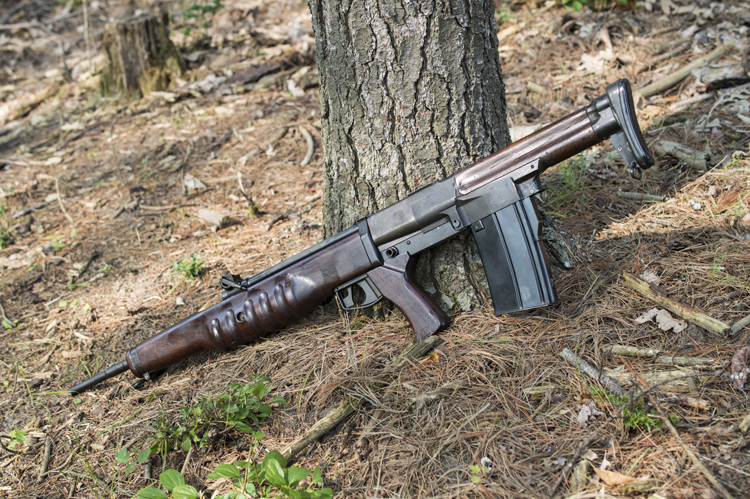
For those gun enthusiasts intrigued by historical firearms, the story of the experimental (and briefly adopted rifle) known simply as the EM-2 has become something of a legend; a sort of Avro Arrow-esque piece of forward-thinking brilliance that was an unfortunate victim of the might of the American military-industrial complex.
In the post-war period, it was obvious to many Allied nations that the guns they’d used to win the war were already outmoded and outstripped by the capability of the creations they faced across the battlefield, especially those encountered later in the war. German rifles like the FG-42, Gewehr 43 (and of course the M1 Garand and M1 Carbine) had demonstrated that semi-automatic arms were going to replace bolt-action rifles as the standard-issue rifle of the future, while the truly groundbreaking StG 44 brought the idea of a select-fire rifle chambered in an intermediate cartridge into reality; a sort of firearm we now call an assault rifle.
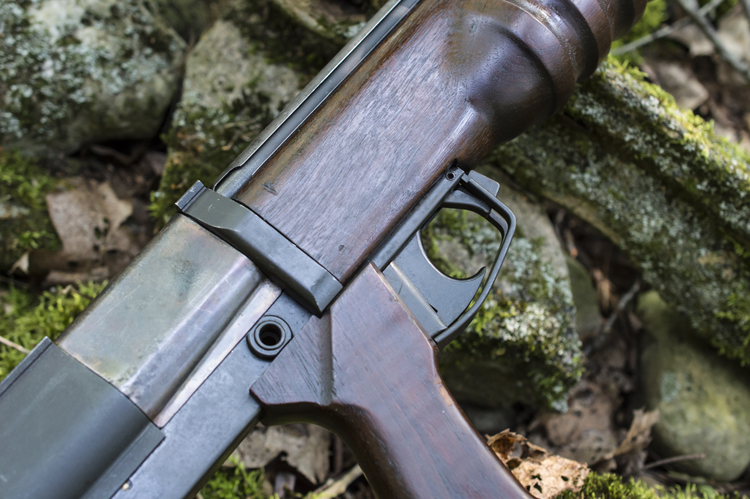
See, up until the StG 44’s creation, standard issue rifles were chambered in larger calibers, largely as a result of the Commonwealth’s issued Lee Enfield rifles being evolutionary products not terribly far removed from the days of volley fire and black powder. However, as technology and ballistics improved at a breakneck pace throughout both world wars, and combat changed, the need for the average infantryman to carry and shoot full-house rifle rounds like .303 and .30-06 was waning. Engagement distances were no longer across vast chasms of no man’s land, nor were they taking place in the large, section- or company-level maneuvers demanded by volley fire. The frenetic pace of battle ushered in by World War II’s mechanized fighting ensured that. Instead, fighting was often taking place from hedgerow to hedgerow or street to street; not exactly where a punchy and slow-firing bolt-action excels.
Recognizing this, the British set about looking to replace the Lee Enfield with something that applied the lessons learned at the hands of the more advanced German weapons. That meant building a select-fire automatic rifle chambered in an intermediate calibre that would allow them to replace both the Lee Enfield rifle and Sten submachine gun.
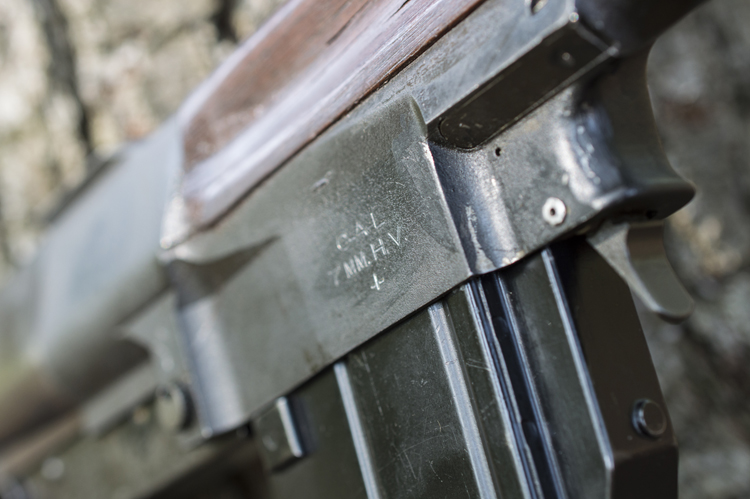
To develop this cartridge, the British commissioned the Ideal Cartridge Panel, which eventually brought forward two cartridges; one .270 and one .276. The .270 was dropped in continued testing, and the .276 continued forward. Denoting the distance across the rifling from the top of one land to another, the .276 round in question actually measured 0.284” across. To further complicate things, the British just decided to call the round the .280 British, perhaps in an effort to average out their previous bore measurement methodology and the projectile diameter.
The bullet itself was a 140-grain full-metal jacketed spitzer, which was propelled out of the muzzle at roughly 2,445 feet per second. In terms of its nearest competitors at the time, it was dramatically more powerful than either 9x19 Luger or 7.92x33mm Kurz. The then-new 7.62x39mm Soviet cartridge came closer, but the .280 British offered 20% more muzzle energy and put up far better performance downrange, delivering roughly 1100 ft-lbs at 300 yards, compared to the 7.62x39’s 640 ft-lbs at the same distance. And it did all this while producing roughly half the recoil of the familiar .303 British round.
Interestingly, while the Ideal Cartridge Panel was busy preparing their replacements for the venerable .303 British, the British military found themselves turning to an a team of engineers comprised almost entirely of immigrants for the design of the rifles that would fire this cartridge. Due to the relative lack of small arms development in England for numerous decades, these primarily Czech, Polish, and Belgian gun designers worked under the office of the Chief Engineer of Armament Design (C.E.A.D.). Having fled their home nations during the Second World War, these immigrants filled a noticeable void in the English military machine, ending decades of lackluster small arms development.
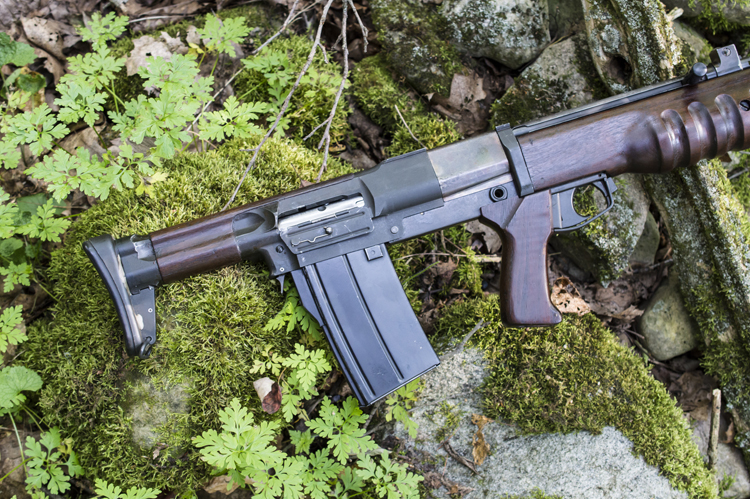
Once installed, the new engineers wasted no time and by 1947 the C.E.A.D., one Roman Korsak, had completed the office’s first project: The EM-1. A hideous gun by any metric, the EM-1 was a bulky and ungainly operation that was roughly analogous to a German FG-42 turned on its side and slightly elongated to form a proper bullpup (the FG-42 being a semi-bullpup already with the fire controls positioned under the feed path), then beaten with an ugly stick, if you can imagine that. Even more problematic, however, was its general bulk and chambering: The EM-1 fired the full-power 8mm Mauser round, precisely what the military was trying to move away from.
While visually it may have been an aberration, and one that functioned only slightly better than it looked, the EM-1’s innovative bullpup layout showed promise and the British military recognized that. And so, right around 1950, the military chose to task the new Chief Engineer of Armament Design with continuing the work that began with Korsak’s EM-1 and evolving it into a more practical and better-performing rifle capable of firing the equally-new .280 British round. The new Chief Engineer had served as Korsak’s understudy during his EM-1 development, and so was very well equipped to evolve the larger rifle into something slightly more modern. His name was Captain Kazimierz-Stefan Januszewski, or as he came to be known by his adopted and Anglicized name, Stefan Kenneth Janson.
Janson’s EM-2 took the very basic receiver layout and design features of his predecessor’s EM-1, such as the pin-retained fire control group and rotate-to-remove butt plate/action spring/guide rod assembly, but traded much of the rest of the previous gun’s FG-42-inspired components for an action that was more closely tied to that of the Gewehr 41 and 43 rifles.
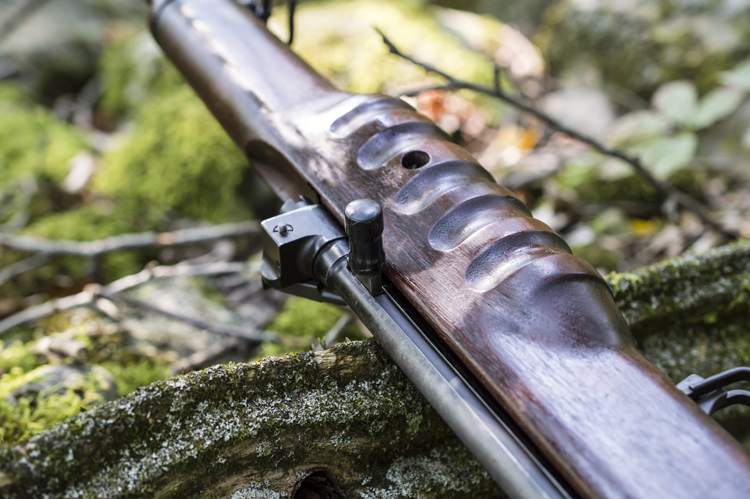
Beginning at the rear of the rifle, a diminutive rubber-clad butt plate serves to retain the reciprocating components inside the receiver; giving it a 60-degree twist releases the butt plate from the receiver and allows the bolt and carrier to be extracted from the rear of the rifle. Forward of the butt plate is a slender, walnut-clad receiver extension, the bottom of which gives way to the relatively substantial magazine well, and the first of the gun’s controls: The magazine and bolt release. Interestingly, both controls are combined in a single paddle that forms the magazine latch; pushing it forward releases the magazine (as expected) while pulling it backwards releases the bolt hold open device. If that sounds like something of an awkward maneuver to do on every reload compared to say, an AR-15 or even a VZ-58, that’s because Janson never intended for the bolt release to be a control that was manipulated on every reload. One of the key components of his design was a bolt hold open device that is engaged by an empty magazine, and disengaged by a loaded one. In other words, when the gun ran dry and the bolt locked to the rear, all the shooter needed to do was stick a fresh magazine in and the bolt would be automatically sent home and the rifle brought back into battery.
And the innovation didn’t stop there. The magazine itself; a relatively burly chunk of steel that would be equally at home on nearly any of the Cold War-era rifles, included a design feature borrowed from the EM-2 Thorpe (a similarly named experimental rifle that competed with the EM-2 Janson pictured here): An integral stripped-clip guide. Installed on the spine of the magazine, this guide could be pulled upwards and clipped onto the top of the magazine to facilitate faster loading of ammunition off stripped clips - a neat idea and one that certainly hearkened back to the stripper clip loading drills familiar to soldiers trained on the Lee Enfield.
Just ahead of the magazine well, near the bottom of the receiver, is a captive pin that serves to retain the fire control group. With the bolt and carrier removed, this pin is pushed through the receiver, and the grip and fire control group is pulled down and out of the receiver. Although made somewhat more complex by the addition of a fire mode selector, the fire control group is surprisingly simple, as the EM-2 is striker-fired. The trigger operates a trigger bar mechanism that transfers the trigger’s rearward movement into the upward movement of a simple sear, which depresses the nose of another sear on the bottom of the bolt, which in turn releases the striker and fires the gun.
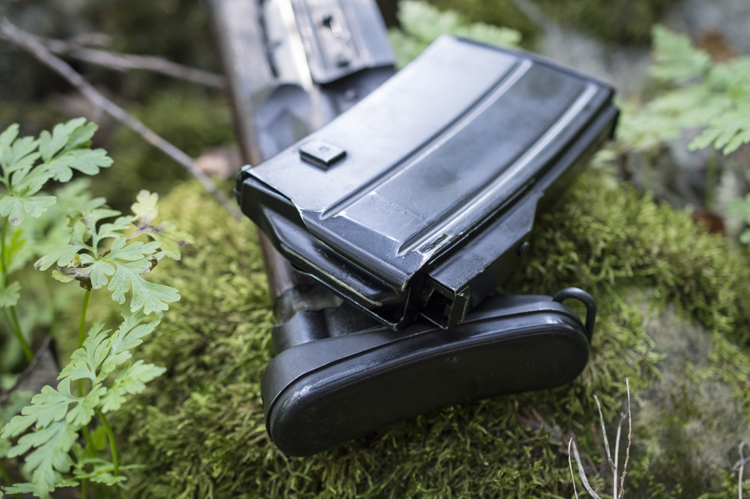
Ahead of the trigger, fitted into the trigger guard, is the safety. Operating like an M1, M1A, or M14 safety, the EM-2’s is easier to operate, and due to its closer proximity to the trigger itself, gives the shooter an immediate indication of the safety’s position when a finger is placed on the trigger. The fire selector is a separate control from the safety, and takes the form of a large transverse button through the receiver that is pushed to the right for semi-automatic fire (as this is very much a right-handed firearm and would generally be kept on semi-automatic), or to the left for fully automatic.
Forward of the trigger lies the reciprocating charging handle. Like the infamous AK-47, the EM-2 is a gas-operated rifle that uses a long-stroke piston, and like that gun, the charging handle is simply affixed to the gas piston assembly. Unlike the AK, however, which features a charging handle that’s integral to a bolt carrier that threads onto the back of the gas piston, the EM-2’s charging handle is affixed to the operating rod portion of the piston just aft of the gas block, which gives it what we today would call a very conventional (and thus forward-thinking for its time) position. Remember, this is a design from late 40s, not the 80s.
Finally, the rifle was finished with a 24.5 inch barrel, for an overall length of 35 inches. For comparison’s sake, that’s roughly 5 inches longer than the 14.5 inch barreled modern M4 carbine in use today and only two inches shorter than Canada’s own C8 carbine. Walnut furniture was fitted, as was the custom in those days, and both a zero-magnification optical sight and a set of backup iron sights were fitted. Early EM-2 optics featured a large dial on the mount that allowed the shooter to adjust his range, while later models such as this featured a fixed sight integrated into a carry handle. The next version of the optic featured broken horizontal lines etched into the reticle with an inverted pointer. The inverted pointer served as the sighting point for all targets up to 300 metres, with the etched lines providing elevation points for 500, 700 and 900 metres. A third variant of the sight featured a C79-like external adjustment drum under the rear of the optic that was rotated to the correct range, tilting the optic to bring the rifle on target. Unfortunately, the rifle pictured here was purchased by the National Historical Arms Museum without the appropriate optic, although a correct optic has been found in private hands and we’re optimistic that this historically relevant EM-2 might someday be complete again. Again, considering this is a rifle conceived in the years immediately after World War II was won with Lee Enfields and 1911s, this must have been space-age technology at the time.
Inside the EM-2, the action quite closely mimics that of the Gewehr 41 and 43, with a pair of quite Remington 870-esque locking flaps that pop out of the sides of the bolt to lock into recesses in the receiver. These flaps are pushed outwards by the firing pin sleeve inside the bolt body. In this state, the gun is locked up and in battery, ready for firing.
The operating rod interfaces with the internal firing pin sleeve via an oval opening in the top of the bolt body. Through this oval opening, a post dangling from the operating rod is fitted into a corresponding hole in the firing pin sleeve.
When the gun is fired, gasses tapped off the bore push the operating rod rearward, which in turn forces the firing pin sleeve backwards inside the still-locked bolt body. As the operating rod forces the firing sleeve rearward, the sleeve first re-cocks the striker. Then, its continued rearward movement forces the flaps to retract into the bolt body. At this point, the continued rearward movement of the operating rod seamlessly brings the bolt out of battery, expending the spent round and loading another.
Contemporary reviewers thought the EM-2 was quite a good gun in a variety of ways, with only a couple significant faults… and one crucial one. The ease with which the gun was fired was perhaps the most notable benefit; at a time when most shooters were used to punchy .303 British, the .280 British in the forgiving piston-driven EM-2 was a notable change in recoil. In a contemporary review in the June 1972 edition of Guns Review magazine, a photo can be found of the gun’s creator, Stefan Kenneth Janson, firing the EM-2 in a one-handed pistol stance.
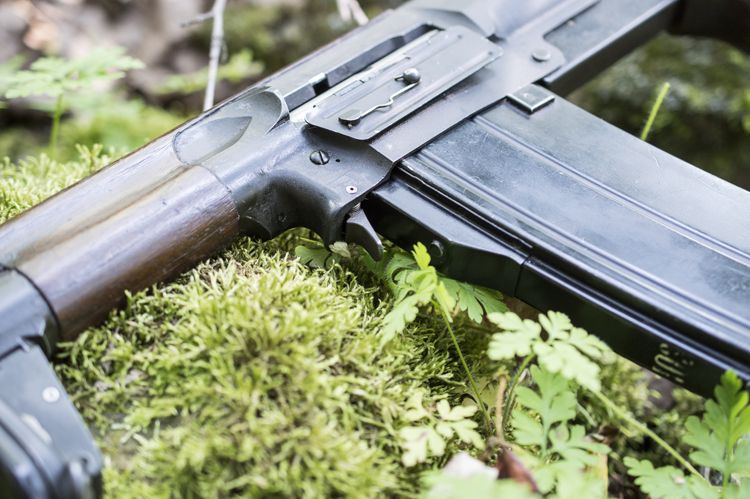
From an engineering perspective, it was equally well received; the dual locking flaps positioned forward on the bolt were noted for their strength and expectedly long service life. This was due to both the large load-bearing surfaces they allowed, and the short stress path their position allowed, which in turn meant less deformation of the locking components than in an action where the stress path was longer (such as the rear-locking Lee Enfield bolt).
The field stripping method was lauded as incredibly simple and field-serviceable, although some thought the “complex” trigger mechanism demanded by the bullpup configuration was overly ornate, and may prove problematic in service. However, it should be noted that the trigger group is quite a bit less complicated than many current service rifles, so what some contemporaries called complexity may have simply been an unwillingness to accept the bullpup platform.
Though many others noted the bullpup platform’s compact size, it wasn’t as big of a feature as you might think. Given the era in which the EM-2 was being evaluated, much of the attitude around gunfighting was still evolving from the early “stand and deliver” methodology of shooting. So while the EM-2 was noted for its ability to get on target quickly, contemporary reviews of the gun didn’t focus on the unique layout nearly as much as one would expect.
However, many did note that the EM-2 is incredibly well sealed against the ingress of dust and dirt. With an action that’s almost completely enveloped in steel, and a receiver that came fitted with a dust cover, the only place dirt could really get in was around the magazine well, and solving that issue would have been simple.
All this combined to make for a very reliable gun. At the EM-2’s trial at Fort Benning, Georgia, Janson’s EM-2 fired 56,800 rounds, 37,000 of which were fired in full auto. Stoppages averaged 4.54 per 1,000 rounds fired overall, and just 3.4 per 1,000 rounds when fired in semi-auto only. For comparison’s sake, an M1 Garand fired alongside the EM-2 averaged 3.84 stoppages per 1,000 rounds. Although we obviously couldn’t run this particular EM-2 through its paces due to the gun’s historical relevance (this is one of the EM-2 prototypes produced by Canadian Arsenals Limited at Long Branch and is serial #1), the accuracy is noted as being acceptable. That same Guns Review article claimed the EM-2 met the British military’s standards of producing a 6-inch or smaller group at 200 yards, with select samples being able to produce a 3-inch group at the same distance.
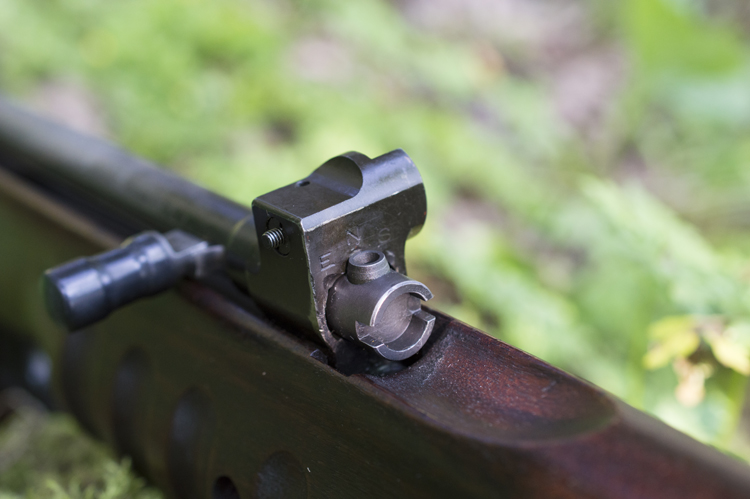
But, as mentioned, the EM-2 wasn’t perfect. First off, the bolt was considered too difficult to disassemble for field stripping. Secondly, the trigger was notoriously bad, with trigger pulls varying from 6.5 to 12 pounds pull-to-pull. Additionally, members of the General Staff were not wholly convinced of the merits of allowing every soldier access to fully automatic fire, and the height-over-bore of the sighting apparatus and ensuing zeroing issues were also somewhat derided. But neither of those were the fatal flaw.
No, the fatal flaw was the work of the Ideal Cartridge Panel, and their .280 British round. As the EM-2 was being tested in Fort Benning, the Americans in attendance made it abundantly clear that regardless of the .280’s excellent ballistic performance, it would not be considered as a replacement for the .30-06 round the Americans were used to. In fact, the Americans made it known that no round smaller than .30 calibre would be accepted.
Nonetheless the British government of the day, with support from the likes of the Armament Design Establishment and the Director of the Infantry, adopted the rifle in 1951 as their general service rifle and called it the No. 9 Mk.1. It would be the shortest-lived rifle in British service history.
In early 1952, with a freshly elected Conservative government headed up by Winston Churchill leading the charge, the adoption of the .280 British round and EM-2 were scrapped. This announcement came shortly after the American statement that they would not be adopting the .280 round as their own and so, Churchill, who himself had distrusted the notion of giving every soldier a fully automatic rifle, opted to shelve the EM-2 and it’s .280 round in favour of continued efforts towards NATO standardization. Of course, those efforts would eventually lead to the adoption of the 7.62x51 NATO round and, in the case of the British military, the FN FAL. It would take decades before NATO would come around to the notion of a smaller, lighter round and rifles capable of larger volumes of fire with the creation of 5.56mm NATO and the M-16.
This rifle, one of the rarest and most prized firearms in the National Historical Arms Museum’s collection, is a prototype EM-2 rifle produced by Canadian Arsenals Limited, and is serial #1. It harkens from a brief period between the original EM-2’s trials and adoption, when many involved in the EM-2 program were attempting to concoct a calibre that would retain the .280’s smaller bullet diameter but address the US concerns about its lethality and terminal ballistics. As a result, this rifle is chambered in 7mm High Velocity. Simply put, 7mm HV took the .280 British and stretched the case out from 43mm to 49.5mm. The shoulder, neck taper and bullet all remained the same, but the powder charge was increased so as to increase the muzzle velocity from 2,415 fps to 2,760 fps. This was the fourth and final attempt to solve the perceived issue with .280 British, the previous attempts having such confidence-inspiring names as “7mm Compromise” and “7mm Second Optimum.”
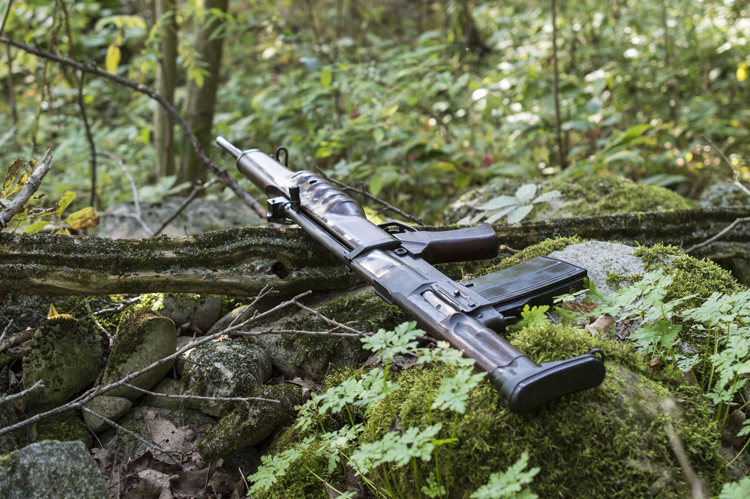
Unfortunately the EM-2 was simply doomed to fail, not so much through any fault of its own, but more so by simply being the wrong gun for the time. When it debuted, “stopping power” was still largely linked to the size of the holes you could punch in the target, and politicians worried about soldiers using fully automatic fire to simply waste ammunition. Today, many of the perceived issues with the EM-2 are simply accepted norms; many militaries (including our own) issue fully-automatic assault rifles to their troops and numerous countries prefer the compact package of the bullpup rifle… including, ironically, England with its stupendously terrible SA80 family of rifles. But, as they say, hindsight always is 20-20.